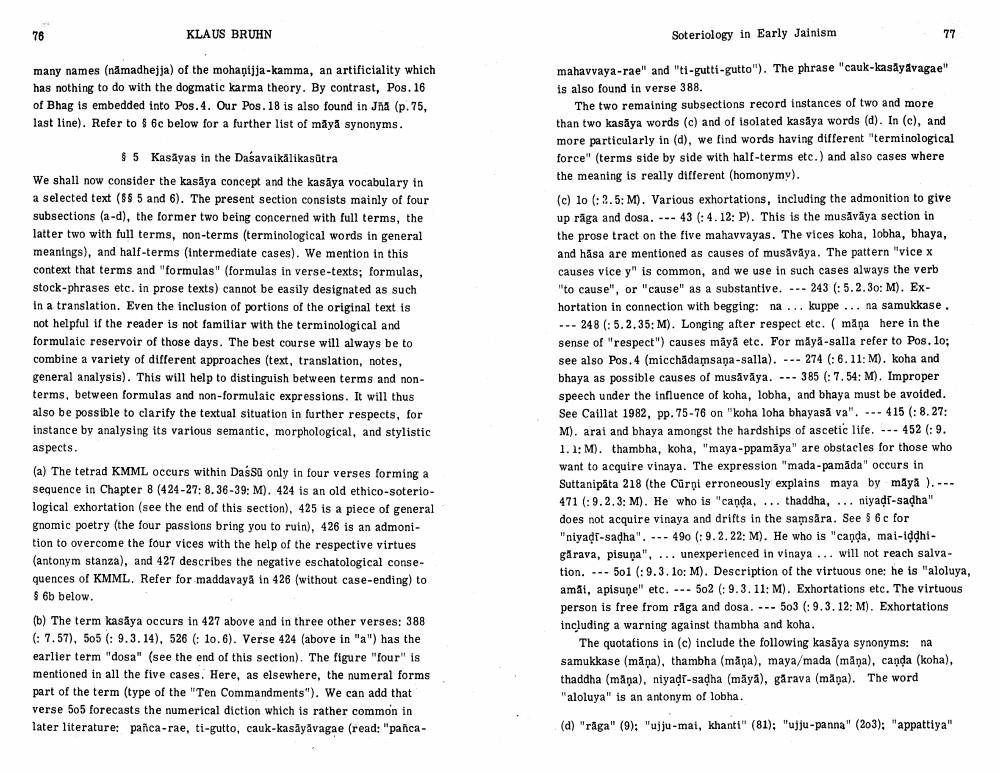________________
76
KLAUS BRUHN
Soteriology in Early Jainism
77
many names (nāmadhejja) of the mohaņijja-kamma, an artificiality which has nothing to do with the dogmatic karma theory. By contrast, Pos. 16 of Bhag is embedded into Pos. 4. Our Pos. 18 is also found in Jha (p.75, last line). Refer to $ 6c below for a further list of maya synonyms.
$5 Kasayas in the Daśavaikälikasūtra We shall now consider the kasāya concept and the kasāya vocabulary in a selected text (86 5 and 6). The present section consists mainly of four subsections (a-d), the former two being concerned with full terms, the latter two with full terms, non-terms (terminological words in general meanings), and half-terms (intermediate cases). We mention in this context that terms and "formulas" (formulas in verse-texts; formulas, stock-phrases etc. in prose texts) cannot be easily designated as such in a translation. Even the inclusion of portions of the original text is not helpful if the reader is not familiar with the terminological and for mulaic reservoir of those days. The best course will always be to combine a variety of different approaches (text, translation, notes, general analysis). This will help to distinguish between terms and nonterms, between formulas and non-formulaic expressions. It will thus also be possible to clarify the textual situation in further respects, for instance by analysing its various semantic, morphological, and stylistic aspects.
mahavvaya-rae" and "t-gutti-gutto"). The phrase "cauk-kasāyavagae" is also found in verse 388.
The two remaining subsections record instances of two and more than two kasāya words (c) and of isolated kasaya words (d). In (c), and more particularly in (d), we find words having different terminological force" (terms side by side with half-terms etc.) and also cases where the meaning is really different (homonymy). (c) lo : 2.5: M). Various exhortations, including the admonition to give up rāga and dosa. --- 43 (: 4.12: P). This is the musavāya section in the prose tract on the five mahavvayas. The vices koha, lobha, bhaya, and hasa are mentioned as causes of musavāya. The pattern "vice x causes vice y" is common, and we use in such cases always the verb "to cause", or "cause" as a substantive. --- 243 (: 5.2.30: M). Exhortation in connection with begging: na... kuppe ... na samukkase. --- 248 (: 5.2.35: M). Longing after respect etc. ( māņa here in the sense of "respect") causes māyā etc. For maya-salla refer to Pos. 1o; see also Pos. 4 (micchādamsana-salla). --- 274 (: 6.11: M). koha and bhaya as possible causes of musăvāya. --- 385 (: 7.54: M). Improper speech under the influence of koha, lobha, and bhaya must be avoided. See Caillat 1982, pp. 75-76 on "koha loha bhayasă va". ... 415 (: 8.27: M). arai and bhaya amongst the hardships of ascetic life. --- 452 (: 9. 1.1: M). thambha, koha, "maya-ppamāya" are obstacles for those who want to acquire vinaya. The expression "mada-pamada" occurs in Suttanipāta 218 (the Cūrni erroneously explains maya by maya ). --- 471 (:9.2.3: M). He who is "canda.... thaddha, ... niyadi-sadha" does not acquire vinaya and drifts in the samsara. See $ 6c for "niyadi-sadha". --- 490 (: 9.2.22: M). He who is "caņda, mai-iddhigarava, pisuņa", ... unexperienced in vinaya ... will not reach salvation. --- 501 (: 9.3. 1o: M). Description of the virtuous one: he is "aloluya, amai, apisune" etc. --- 502 (: 9.3. 11:M). Exhortations etc. The virtuous person is free from räga and dosa. --- 503 (:9.3.12: M). Exhortations including a warning against thambha and koha.
The quotations in (c) include the following kasāya synonyms: na samukkase (mana), thambha (māņa), maya/mada (mana), canda (koha). thaddha (mapa), niyadi-sadha (māyā), gärava (mana). The word "aloluya" is an antonym of lobha.
(a) The tetrad KMML occurs within Dassu only in four verses forming a sequence in Chapter 8 (424-27: 8.36-39: M). 424 is an old ethico-soteriological exhortation (see the end of this section), 425 is a piece of general gnomic poetry (the four passions bring you to ruin), 426 is an admonition to overcome the four vices with the help of the respective virtues (antonym stanza), and 427 describes the negative eschatological consequences of KMML. Refer for maddavaya in 426 (without case-ending) to $ 6b below. (b) The term kasāya occurs in 427 above and in three other verses: 388 : 7.57), 505 (: 9.3. 14), 526 : 10.6). Verse 424 (above in "a") has the earlier term "dosa" (see the end of this section). The figure "four" is mentioned in all the five cases. Here, as elsewhere, the numeral forms part of the term (type of the "Ten Commandments"). We can add that verse 505 forecasts the numerical diction which is rather common in later literature: panca-rae, ti-gutto, cauk-kasāyāvagae (read: "panca -
(d) "raga" (9): "ujju-mai, khanti" (81); "ujju-panna" (203); "appattiya"




